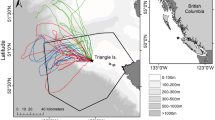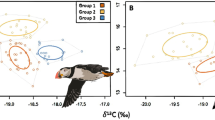Abstract
Miniature geolocator loggers (Global Location Sensing, GLS) that provide daily locations of birds have revolutionised the study of winter ecology and migration patterns of seabirds. A long-term study of ringing recoveries and analyses of heavy metals and pollutants in tissues of Atlantic puffins Fratercula arctica from the Isle of May, south-east Scotland, suggested that this population wintered mainly within the North Sea. However, deployment of GLS devices over the 2007/2008 winter showed that many breeding birds made major excursions into the east Atlantic. This winter was the second of two when survival was extremely low (survival in 2006/2007 and 2007/2008 was 0.696 and 0.695, respectively, compared to the average of 0.922 over the period 1984/1985–2005/2006). These low rates of survival suggested that the unexpected use of the Atlantic might have been associated with unusually poor conditions in the North Sea as indicated by very low breeding success in 2007. Survival rate returned to previous levels in 2008/2009 providing the opportunity to test whether higher survival was associated with birds remaining in the North Sea, or whether movements into the Atlantic are a feature of this population unrelated to survival. Accordingly, geolocators were deployed over the 2009/2010 winter when adult survival was subsequently established to be high (0.913). We found greater support for the hypothesis that winter distribution is not associated with survival. Thus, 8 (40 %) of 20 individuals followed in 2009/2010 went into the Atlantic, a rate not significantly different from 11 (58 %) of the 19 followed in the 2007/2008 winter. Indeed, birds actually spent longer in the Atlantic and used a wider variety of areas in 2009/2010, although the time spent away from the colony was significantly shorter than in 2007/2008. Since our data were from individuals that survived, remaining in or moving out of the North Sea can both be successful strategies during winters when the population as a whole shows either high or low survival rates. Unfortunately, we do not know where birds that died had gone, and hence, the relative survival of birds that did or did not move into the Atlantic. Determining the link between survival and wintering area for any seabird remains a formidable challenge and will have to await the development of technologies that can determine both where and when birds die.



Similar content being viewed by others
References
Adriaensen F, Dhondt AA (1990) Population dynamics and partial migration of the European robin (Erithacus rubecula) in different habitats. J Anim Ecol 59:1077–1090
Alvarez-Fernandez S, Lindeboom H, Meesters E (2012) Temporal changes in plankton of the North Sea: community shifts and environmental drivers. Mar Ecol Progr Ser 462:21–38
Barrett RT, Lorentsen S-H, Anker-Nilssen T (2006) The status of breeding seabirds in mainland Norway. Atlantic Seabirds 8:97–126
Bogdanova MI, Daunt F, Newell M, Phillips RA, Harris MP, Wanless S (2011) Seasonal interactions in the black-legged kittiwake, Rissa tridactyla: links between breeding performance and winter distribution. Proc R Soc Lond B 278:2412–2418
Carey MJ, Meathrel CE, May NA (2009) A new method for the long-term attachment of data-loggers to shearwaters (Procellariidae). Emu 109:310–315
Catry P, Dias MP, Phillips RA, Granadeiro JP (2013) Carry-over effects from breeding modulate the annual cycle of a long-distance migrant. An experimental demonstration. Ecology http://dx.doi.org/10.1890/12-2177.1
Croxall JP, Silk JRD, Phillips RA, Afanasyev V, Briggs DR (2005) Global circumnavigations: tracking year-round ranges of non-breeding albatrosses. Science 307:249–250
Dias MP, Granadeiro JP, Phillips RA, Alonso H, Catry P (2011) Breaking the routine: individual Cory’s shearwaters shift winter destinations between hemispheres and across ocean basins. Proc R Soc Lond B 278:1786–1793
Drent R, Both C, Green M, Madsen J, Piersma T (2003) Pay-offs and penalties of competing migratory schedules. Oikos 103:274–292
Egevang C, Stenhouse IJ, Phillips RA, Petersen A, Fox JW, Silk JRD (2010) Tracking of Arctic terns Sterna paradisaea reveals longest animal migration. Proc Natl Acad Sci USA 107:2078–2081
Elliott KH, McFarlane-Tranquilla L, Burke CM, Hedd A, Montevecchi WA, Anderson WG (2012) Year-long deployments of small geolocators increase cortisterone levels in murres. Mar Ecol Prog Ser 466:1–7
Falk K, Jensen JK, Kampp K (1992) Winter diet of Atlantic Puffins (Fratercula arctica) in the Northeast Atlantic. Col Waterbird 15:230–235
Fifield DA (2011) Winter areas and migratory tactics of northern gannets (Morus bassanus) breeding in North America. MSc thesis, St. John’s, Newfoundland
Frederiksen M, Moe B, Daunt F, Phillips RA, Barrett RT, Bogdanova MI, Boulinier T, Chardine JW, Chastel O, Chivers LS, Christensen-Dalsgaard S, Clement-Chastel C, Colhoun K, Freeman R, Gaston AJ, Gonzalez-Solis J, Goutte A, Gremillet D, Guilford T, Jensen GH, Krasnov Y, Lorentsen SH, Mallory ML, Newell M, Olsen B, Shaw D, Steen H, Strom H, Systad GH, Thorarinsson TL, Anker-Nilssen T (2012) Multicolony tracking reveals the winter distribution of a pelagic seabird on an ocean basin scale. Divers Distrib 18:530–542
Gelman A, Rubin DB (1992) Inference from iterative simulation using multiple sequences. Stat Sci 7:457–472
Gillis EA, Green DJ, Middleton HA, Morrissey CA (2008) Life history correlates of alternative migratory strategies in American Dippers. Ecology 89:1687–1695
Griffiths R, Daan S, Dijkstra C (1996) Sex identification in birds using two CHD genes. Proc R Soc Lond B 263:1251–1256
Guilford T, Meade J, Willis J, Phillips RA, Boyle D, Roberts S, Collett M, Freeman R, Perrins CM (2009) Migration and stopover in a small pelagic seabird, the Manx shearwater Puffinus puffinus: insights from machine learning. Proc R Soc Lond B 276:1215–1223
Guilford T, Freeman R, Boyle D, Dean B, Kirk H, Phillips R, Perrins C (2011) A dispersive migration in the Atlantic puffin and its implications for migratory navigation. PLos ONE e21336. doi:10.1371/journal.pone.0021336
Harris MP (1984a) Movements and mortality patterns of north Atlantic puffins as shown by ringing. Bird Study 31:131–140
Harris MP (1984b) The puffin. T. and A. D. Poyser, Calton
Harris MP, Wanless S (2011) The puffin. T. and A. D. Poyser, London
Harris MP, Anker-Nilssen T, McCleery RH, Erikstad KE, Shaw DN, Grosbois V (2005) Effect of wintering area and climate on the survival of adult Atlantic puffins Fratercula arctica in the eastern Atlantic. Mar Ecol Prog Ser 297:283–296
Harris MP, Daunt F, Newell M, Philips RA, Wanless S (2010) Wintering areas of adult Atlantic puffins Fratercula arctica from a North Sea colony as revealed by geolocation technology. Mar Biol 157:827–836
Harris MP, Bogdanova MI, Daunt F, Wanless S (2012) Using GPS technology to assess feeding areas of Atlantic Puffins Fratercula arctica. Ring Migr 27:43–49
Hebblewhite M, Merrill EH (2011) Demographic balancing of migrant and resident elk in a partially migratory population through forage-predation tradeoffs. Oikos 120:1860–1870
Hedd A, Fifield DA, Burke CM, Montevecchi WA, Tranquilla LM, Regular PM, Buren AD, Robertson GJ (2010) Seasonal shift in the foraging niche of Atlantic puffins Fratercula arctica revealed by stable isotope (delta N-15 and delta C-13) analyses. Aquat Biol 9:13–22
Hill RD (1994) Theory of geolocation by light levels. In: LeBoef BJ, Laws RM (eds) Elephant seals: population ecology, behaviour and physiology. University of California Press, Berkeley
Inger R, Harrison XA, Ruxton GD, Newton J, Colhoun K, Gudmundsson GA, McElwaine G, Pickford M, Hodgson D, Bearhop S (2010) Carry-over effects reveal reproductive costs in a long-distance migrant. J Anim Ecol 79:974–982
Jessopp MJ, Cronin M, Doyle TK, Wilson M, McQuatters-Gollop A, Newton S, Phillips RA (2013) Transatlantic migration by post-breeding puffins: a strategy to exploit a temporarily abundant food source. Mar Biol. doi:10.1007/s00227-013-2268-7
JNCC (2012) Seabird Population Trends and Causes of Change: 2012 Report (http://www.jncc.defra.gov.uk/page-3201). Joint Nature Conservation Committee. Updated July 2012. Accessed 1 December 2012
King R, Morgan BJT, Gimenez O, Brooks SP (2009) Bayesian analysis for population ecology. Chapman & Hall, London
Lahoz-Monfort JJ, Morgan BJT, Harris MP, Wanless S, Freeman SN (2011) A capture–recapture model for exploring multi-species synchrony in survival. Method Ecol Evol 2:116–124
Landers TJ, Rayner MJ, Phillips RA, Hauber ME (2011) Dynamics of seasonal movements by a trans-Pacific migrant, the Westland petrel. The Condor 113:71–79
Loison A, Saether BE, Jerstad K, Rostad OW (2002) Disentangling the sources of variation in the survival of the European dipper. J Appl Stat 29:289–304
Lundberg P (1988) The evolution of partial migration in birds. Trends Ecol Evol 3:172–175
Montevecchi W, Fifield D, Burke C, Garthe S, Hedd A, Rail J-F, Robertson G (2012) Tracking long-distance migration to assess marine pollution impact. Biol Lett 8:218–221
Newton I (1998) Population limitation in birds. Academic Press, London
Newton I (2008) The migration ecology of birds. Academic Press, London
Phillips RA, Silk JRD, Croxall JP, Afanasyev V, Briggs DR (2004) Accuracy of geolocation estimates for flying seabirds. Mar Ecol Prog Ser 266:265–272
Phillips RA, Silk JRD, Croxall JP (2005) Foraging and provisioning strategies of the light-mantled sooty albatross at South Georgia: competition and co-existence with sympatric pelagic predators. Mar Ecol Prog Ser 285:259–270
Plummer M (2003) JAGS: a program for analysis of Bayesian graphical models using Gibbs sampling. 3rd International workshop on distributed statistical computing, Vienna. http://www.ci.tuwien.ac.at/Conferences/DSC-2003/
Plummer M, Best N, Cowles K, Vines K (2006) CODA: convergence diagnosis and output analysis for MCMC. R News 6:7–11
Pradel R (1993) Flexibility in survival analysis from recapture data: Handling trap-dependence. In: Lebreton JD, North PM (eds) Marked individuals in the study of bird population. Birkhaeuser Verlag, Basel
Quillfeldt P, McGill RAR, Furness RW, Moestl E, Ludynia K, Masello JF (2012) Impact of miniature geolocation loggers on a small petrel, the thin-billed prion Pachyptila belcheri. Mar Biol 159:1809–1816
Raine AF, Borg JJ, Raine H, Phillips RA (2013) Migration strategies of the Yelkouan Shearwater Puffinus yelkouan. J Ornithol 15:411–422
Sanz-Aguilar A, Bechet A, Germain C, Johnson AR, Pradel R (2012) To leave or not to leave: survival trade-offs between different migratory strategies in the greater flamingo. J Anim Ecol 81:1171–1182
Vandenabeele SP, Shepard EL, Grogan A, Wilson RP (2012) When three per cent may not be three per cent; device-equipped seabirds experience variable flight constraints. Mar Biol 159:1–14
Wernham CV, Toms M, Marchant JH, Clark J, Siriwardena G, Baillie SR (2002) The migration atlas; movements of birds of Britain and Ireland. T. & A. D. Poyser, London
Williams BK, Nichols JD, Conroy MJ (2002) Analysis and management of animal populations. Academic Press, San Diego
Wilson RP, Ducamp JJ, Rees G, Culik BM, Niekamp K (1992) Estimation of location: global coverage using light intensity. In: Priede IM, Swift SM (eds) Wildlife telemetry: remote monitoring and tracking of animals. Ellis Horward, Chichester
Acknowledgments
We thank J. Fox and V. Afanasyev for GLS device development, Scottish Natural Heritage for allowing us to work on the Isle of May National Nature Reserve and the Joint Nature Conservation Committee (on behalf of Natural England, Scottish Natural Heritage, the Countryside Council for Wales and the Council for Nature Conservation and the Countryside in Northern Ireland) for financial support for the collection of survival data and three anonymous reviewers for their very positive and helpful comments on a previous version of the manuscript. JJLM was supported by the National Environment Research Program (NERP) Decisions Hub.
Author information
Authors and Affiliations
Corresponding author
Additional information
Communicated by S. Garthe.
Rights and permissions
About this article
Cite this article
Harris, M.P., Daunt, F., Bogdanova, M.I. et al. Inter-year differences in survival of Atlantic puffins Fratercula arctica are not associated with winter distribution. Mar Biol 160, 2877–2889 (2013). https://doi.org/10.1007/s00227-013-2278-5
Received:
Accepted:
Published:
Issue Date:
DOI: https://doi.org/10.1007/s00227-013-2278-5




